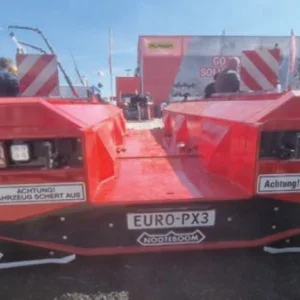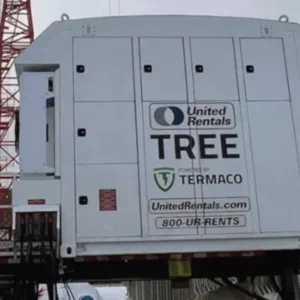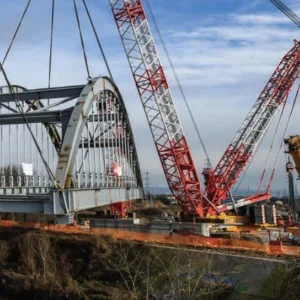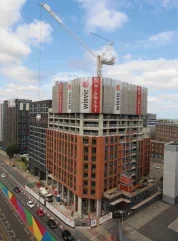
In the centre of Birmingham a Potain MR225 top slewing (luffing jib) tower crane of 14-tonne capacity is building a 33-storey student accommodation block. It is constructing the hybrid precast and in-situ concrete frame; it is installing the unitised curtain wall façade, of some 2,600 floor-to-floor height external wall panels which are factory manufactured and delivered to site fully complete with brickwork and windows; it is also distributing internal fit-out materials, such as pre-fabricated bathroom pods.
The crane is on hire from Radius Group to Northampton, UK-based construction company Winvic, and work is progressing smoothly. There does seem to be something missing, though.
If you look up, possibly through binoculars, at the crane operating cabin, some 70-odd metres above ground at the top of the tower below the boom, the operator appears to be absent. The cabin is empty. Lifting, moving, lowering of loads nevertheless continues.
The operator has not gone on an extended tea-break. They are, in fact, hard at work – only not in the usual place. Instead the operator is in a cockpit on the ground. Even so they can see exactly what they are doing – and can do so possibly better than if they were in their normal sky-high cabin.
A bank of monitors surrounds the operator, fed by cameras mounted on the crane. Crane control levers are at hand and operate the crane remotely from the operator’s rather-morecomfortable new place of work.
And they have not had to spend time, and effort, climbing 33 wind and rain-exposed storeys to reach the crane cabin.
The tower crane is being operated remotely from ground level. It is the first time such a system has been used in the UK. It promises to transform work, and working conditions, throughout the sector.
SKYLINE COCKPIT
The new system is called Skyline Cockpit. It has been developed by Israeli company Skyline Cranes and Technologies, owners of Israel’s largest crane fleet, in collaboration with Winvic and lifting solutions provider the Radius Group.
Since the summer Radius has been offering demonstration days for the technology at its Northampton headquarters.
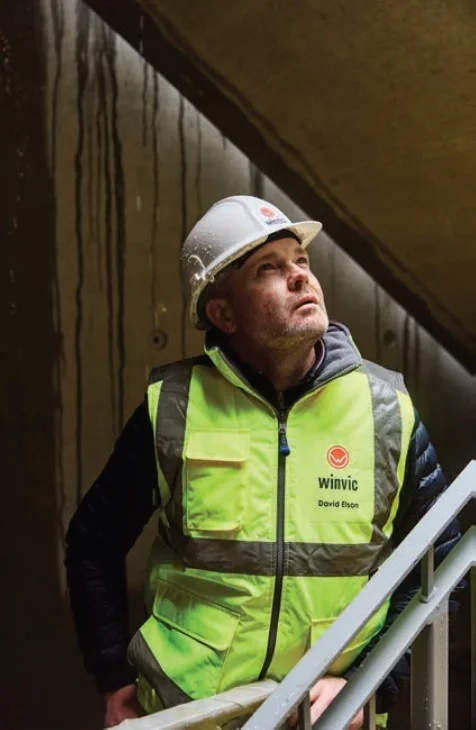
“Radius Group has never been afraid to do things differently and we pride ourselves on being at the forefront of lifting technology,” says managing director Michael Fryer. “I am extremely proud and excited to be leading the way in tower crane innovation by being the first tower crane supplier to offer the Skyline Cockpit on live sites.
“It is always daunting being the first to do something new but somebody must take the lead and I feel the time is right for Radius Group to lead the way.”
REINVENTING THE EXPERIENCE
“Skyline Cockpit started with the crane operator at its heart,” explains Skyline co-CEO Aviv Carmel. “Throughout our global travels and conferences we consistently identified a looming issue in our industry: the next generation is veering away from the isolated, weather-worn cabins suspended high in the air. The appeal of being a crane operator is waning.
Because operating a tower crane is, let’s face it, not the most attractive of careers on offer to a young person setting out on their working life. It is skilled, certainly; but it is not exactly companionable. There is no one up there to talk to and share a coffee with and comfort breaks are not easy, either.
Technology is making all kinds of new things possible, as daily news reports make clear. News reports, though, tend to focus on wars and conflicts. “Our vision was clear,” says Carmel. ”If drones in Iraq can be operated from Texas why not cranes from the ground?
“We weren’t just bringing cranes to the ground; we were reinventing the whole experience. Equipped with radars, lasers, cameras, and sensors, the operator now has a dashboard like a pilot’s. Information on wind direction and exact cargo landing and take-off points is readily available.”
INCLUSIVE APPROACH
So the cabin on the ground makes the operator’s job both more comfortable and safer. It also opens the job up to many more people. Those with disabilities, for example; and those whom one would normally imagine to be least well-suited to life at the top of a tower crane, namely those with a fear of heights!
Winvic’s tower crane operator at the Birmingham Crown Place site is a prime example. The cabin on the ground saves him time and makes him more efficient. “I have a fear of heights,” he reveals. “When I started as a tower crane operator it used to take me longer to climb the crane and come down. I used to stop at every level to get used to the height.
“I think the new technology is a step towards the future. It could push a lot more younger people to work on crane operating.”
DATA PROVIDER
The revolution, however, is not just for operators says Skyline.
“The wealth of data we accumulated was invaluable for the entire construction team, from foremen to safety managers,” Carmel continues. “With real-time data streaming, the entire team could collaborate more effectively. The operator, signal person, and foreman can jointly analyse data, even magnifying visuals to inspect minute details.”
The cabin contains a large panoramic screen, measuring 2.1 by 1.2 metres, which shows simultaneous views from the seven cameras placed on the crane. Sophisticated software interweaves these visuals, combining the output from the cameras to create a panoramic view of the site. The cameras also provide up to 40% zoom resolution, allowing the crane operator to see areas that would typically be out of their line of sight. They also use augmented reality (AR) to display the load line, expected landing spot, as well as real-time indicators including wind speed, slew, lifting, hoist, jib, and radius data.
“The view captures every essential angle, including perspectives from the trolley winch, the lift winch, and the (now unoccupied) cabin giving a clear view of the hook and load line.
“On top of that the AR layer anticipates the exact landing spot in real time. Proprietary algorithms provide real-time alerts and critical data, including safety warnings, based on weather and wind data during lifting tasks,” says Carmel.
Returning to Winvic, the Crown Place Birmingham project is the tallest it has worked on to date; the building will comprise 33 storeys when complete. The crane initially stood at 77 metres, but it will be climbed throughout construction to a maximum height of 102 metres.
Winvic’s commitment to health, safety and wellbeing were, it says, key drivers for the selection of the new technology, but daily and weekly analytics reports available through the Skyline Cockpit cloud portal also allow for efficiencies to be analysed.
A 12-week trial period of Skyline Cockpit has now concluded. Its resounding success means Winvic will continue to use the remote operation technology for the remainder of the project; handover of the scheme to client Crown Student Living is scheduled for December 2025.
UK FIRST
David Elson is senior operations manager at Winvic. “Skyline Cockpit has been used on European projects,” he says, “and Winvic is the first main contractor in the UK to utilise the technology. The project had already commenced and the tower crane already erected when the opportunity arose to partner with Skyline Cockpit, so the cameras were installed on the tower crane in situ. We undertook a 12week trial period to evaluate the safety, wellbeing and efficiency benefits, and the successful results lead to Winvic choosing to maintain the remote tower crane technology at Crown Place Birmingham through to the scheme’s completion.”
MULTIPLE BENEFITS
There are obvious advantages to the Skyline Cockpit system – not least saving the operator from isolation and making their working day more pleasant – but there are others as well…
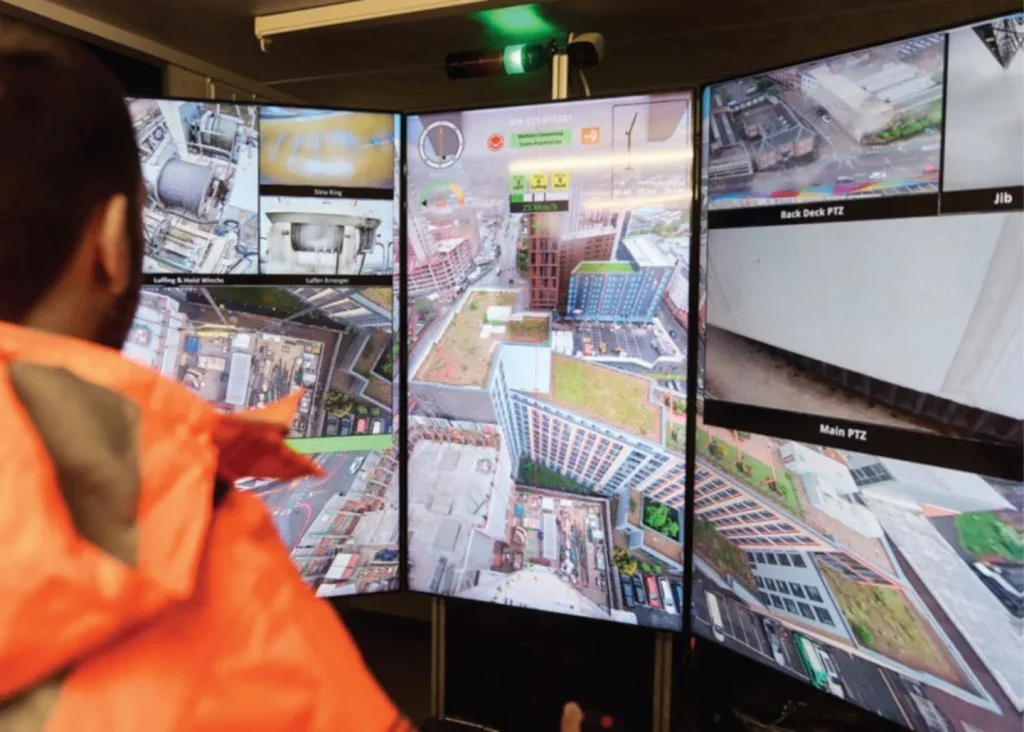
“Health, safety and wellbeing are of paramount importance to Winvic,” says Elson, “but we are also continually exploring new technologies in all areas because innovation is in the company’s DNA. Sometimes safety is the driver, or it could be for sustainability, quality or efficiency purposes. With Skyline Cockpit it was evident there were many benefits that met our aims, particularly on a site as compact and a building as tall as Crown Place Birmingham.
“The multiple cameras with 40 percent zoom give our crane operators enhanced vision capacities and remove blind spots, and the array of realtime data on the panoramic screens accelerate safetyfirst decision making.
“Skyline Cockpit also eliminates the need for a team member to climb up and down a crane mast several times a day. Plus, operators can easily access welfare facilities whenever they need to, they can stay in the specialist control centre and have valuable face-to-face conversations about works.”
EFFICIENCY GAINS
“The system also generates alerts when it’s not being utilised efficiently, so we’ve been able to apply learnings to gain ten per cent lifting productivity,” Elson continues. “Crown Place Birmingham is the only project we have used the system on so far; but our collaborative partnership with Skyline Cockpit and our subcontractor Radius Group means we can access multiple systems if and when required.”
Is Winvic planning to make the system universal on all their tower cranes, or just use it for especially high-rise or complex projects?
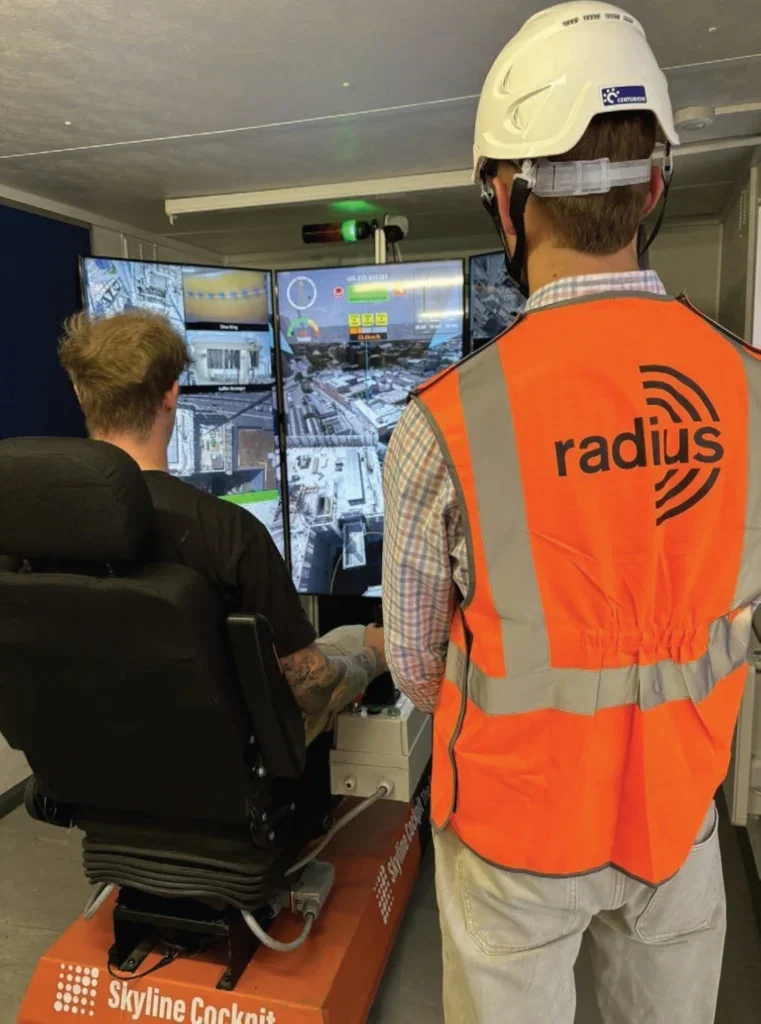
“The challenges are likely to be similar for tower crane operations everywhere,” says Elson, “and it comes down to making sure everybody on site goes home safely that night. Skyline Cockpit has been welcomed by the whole site team and project managers from our other high-rise projects have visited out site to see it in action for themselves.
“Each new project will be assessed on a case by case basis, and factors such as the building’s height, visibility, materials, construction method, compactness of site and other complexities will be considered. Nevertheless, we have every intention of using the technology on other projects.”
Delivery of the ground-based control cabin to the worksite is straightforward. “The Skyline cockpit technology can be housed in any location: theoretically you could operate the crane from anywhere in the world,” Elson explains. “The benefits of having the crane operator in walking distance of the team, however, means we have it located on level one of the project in a 24 foot welfare container with access to electricity and water.”
The feedback from several tower crane operators who have been trained to use Skyline Cockpit has been positive.
“They report their role is simpler due to the increased visibility, functionality and data, while the face-to-face communication that the technology affords with other team members boosts their efficiency, general enjoyment and wellbeing,” Elson remarks.
Being able to visit the bathroom and make a hot drink – easily – and whenever the operative wants is also a significant benefit, one which most people take for granted while they’re at work.
DIGITAL WORLD
“Winvic works closely with numerous education providers and… technologies like Skyline Cockpit are helping to make construction an appealing career option,” Elson continues. “Bringing the crane operator down to the ground is the first step towards more automation and optimisation of construction sites – and for the younger digital generation this is their world.”
Does he see it becoming a universal tool, with top-of-thetower cabins becoming obsolete?
“I am sure this technology will be adopted across more of our high-rise projects using tower cranes in the future but these things always take time. It wasn’t that long ago, however, that Building Information Modelling and digital design was used by just a few, and now we’re linking models to Augmented Reality technology to undertake quality control assessments in the as-built environment.
“I don’t doubt this is just one technology in a long line of future innovations for the construction industry, which augment productivity, accuracy and safety. The next generation will include optimisation of the crane operations, through driving assistance, in-depth data analytics, and integration with Building Information Modelling (BIM) digital designs.
“Other tools we are using at Crown Place Birmingham provide an insight into the transformation of construction operations and management. The next ten years are going to be exciting.
“For example, we’re a project partner with HP SitePrint, which is a BIM linked robot that travels across a constructed floor slab and prints all the required marks for all the ongoing trades. This type of technology unlocks productivity and quality like never before.”
Construction is evolving. The digital revolution has changed all kinds of working scenarios but, until now, the harsh environments of outside construction sites has meant that transformation has been slower to take root here compared to easier and more predictable indoor workspaces.
The Skyline cockpit may well be just the first step along a road. Robotics for bricklaying and other tasks, automated vehicles, AI controlled site planning… the next few years are likely to be transformative; and construction work may well make fewer physical demands, and become less stressful and much more attractive to young people starting out on a new career.


